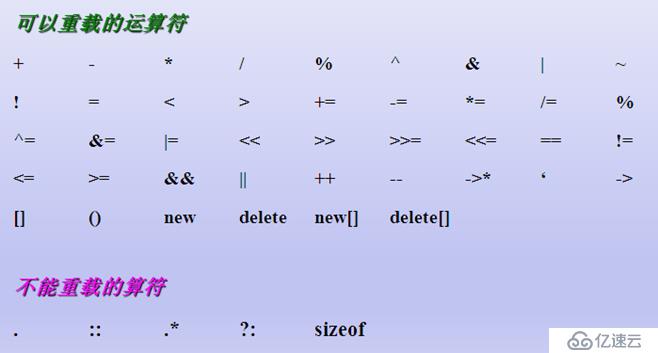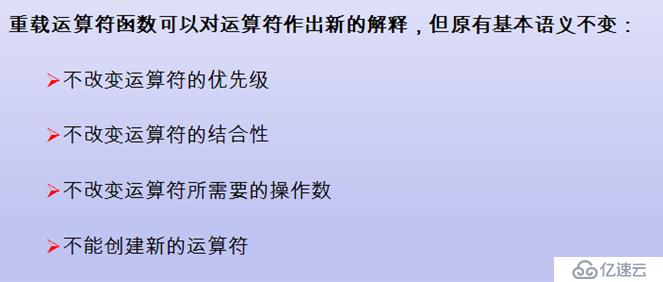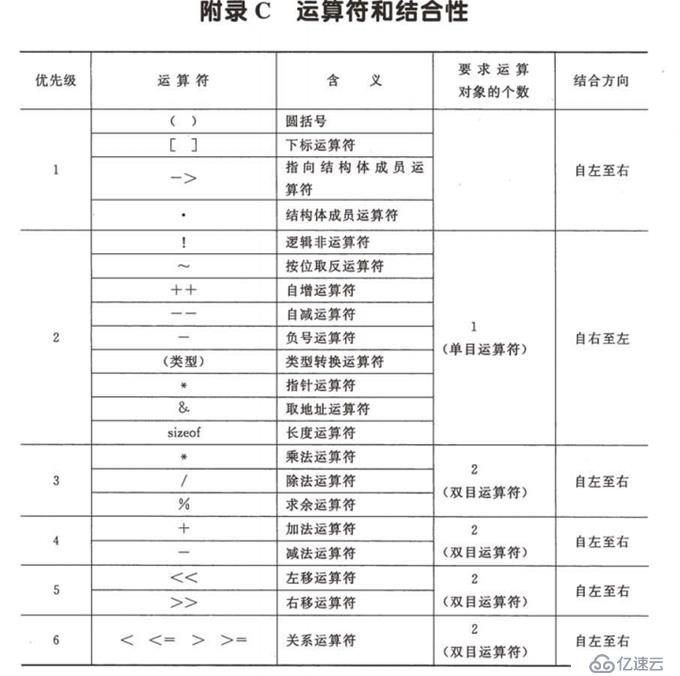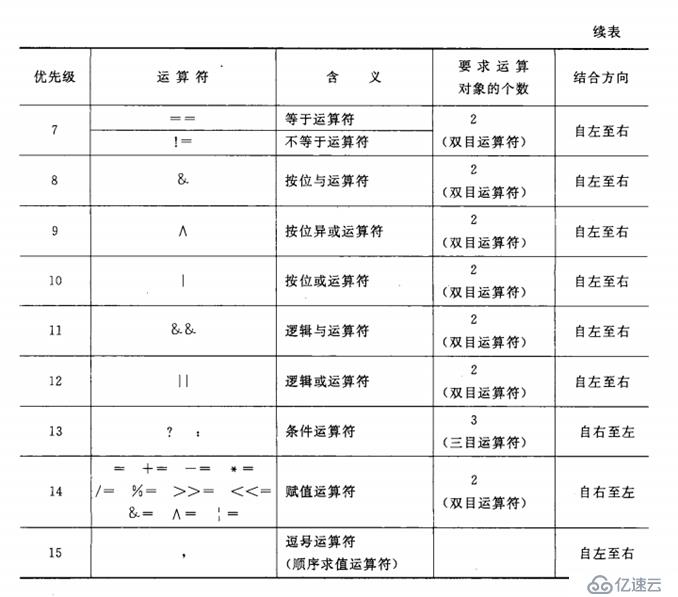您好,登錄后才能下訂單哦!
您好,登錄后才能下訂單哦!
1)
請問類中函數 const修飾的誰
把類中的成員函數 轉換成全局函數
成員函數返回*this
2)
自定義數組類封裝 申明 與實現分開寫 具有以下函數
void arr_set(int n,int value);
int arr_get(int n);
int arr_len()
3)
為什么會有友元函數
友元類:
4)
運算符重載
可以進行運算符重載的符
【二元操作符】 + -
全局函數的運算符重載,private成員變量
成員函數的運算符重載,private成員變量
【一元運算符】
成員函數,全局函數
前置++ 后置++
前置-- 后置--
有元函數的正真使用場景:
返回引用類型,鏈式輸出對象的信息
5)
【難點】運算符重載提高
等號=
中括號[],當左值,當右值
相等符號 ==
不等于 !=
6)作業:封裝一個字符類,使用 << ,>>,!= ,==,=,
附:運算符結合方向:
1,請問類中函數 const修飾的誰?
chunli@Linux:~/c++$ cat main.cpp
#include <iostream>
#include <stdlib.h>
using namespace std;
class A
{
public:
//const的三種寫法
//const void fun(int a,int b)
//void const fun(int a,int b)
//void fun(int a,int b) const
void fun(int a,int b) const
{
a = 100; //const 修飾的不是a
//this->a = 200; //編譯提示:‘A::a’ in read-only object
}
private:
int a;
int b;
};
int main()
{
A a1;
return 0;
}答案:
const的三種寫法修飾的是this指針
const void fun(int a,int b)
void const fun(int a,int b)
void fun(int a,int b) const
this指針所指向的內存空間不能被修改
相當于 void fun(const A *this,int a,int b)
修改this指針本身的值,編譯也不通過
把類中的成員函數 轉換成全局函數
chunli@Linux:~/c++$ cat main.cpp
#include <iostream>
#include <stdlib.h>
using namespace std;
class A
{
public:
void fun()
{
cout << "a="<<this->a<<" b="<<this->b<< " in fun"<<endl;
}
A(int a=0,int b=0)
{
this->a = a;
this->b = b;
cout << "a="<<this->a<<" b="<<this->b<<" in init \n";
}
A add(A &a)
{
A t(this->a + a.a,this->b + a.b);
return t;
}
A (const A &obj)
{
cout << "in copy \n";
}
~A()
{
cout << "a= "<<a << " b="<<b <<" free\n";
}
public:
int a;
int b;
};
//把成員函數轉成全局函數
A fun(A &a1,A &a2)
{
A a3;
return a3;
}
void fun1()
{
cout << "-------- in fun1 ------------------- \n";
A a1(1,2);
A a2(3,4);
A a3 = a1.add(a2); a3.fun();
}
void fun2()
{
cout << "-------- in fun2 ------------------- \n";
A a1(1,2);
A a2(3,4);
A a3(5,5); a3 = a1.add(a2); a3.fun();
}
int main()
{
fun1();
fun2();
return 0;
}
chunli@Linux:~/c++$ g++ -g main.cpp && ./a.out
-------- in fun1 -------------------
a=1 b=2 in init
a=3 b=4 in init
a=4 b=6 in init
a=4 b=6 in fun
a= 4 b=6 free
a= 3 b=4 free
a= 1 b=2 free
-------- in fun2 -------------------
a=1 b=2 in init
a=3 b=4 in init
a=5 b=5 in init
a=4 b=6 in init
a= 4 b=6 free
a=4 b=6 in fun
a= 4 b=6 free
a= 3 b=4 free
a= 1 b=2 free成員函數返回*this
chunli@Linux:~/c++$ cat main.cpp
#include <iostream>
#include <stdlib.h>
using namespace std;
class A
{
public:
void fun()
{
cout << "a="<<this->a<<" b="<<this->b<< " in print"<<endl;
}
A(int a=0,int b=0)
{
this->a = a;
this->b = b;
cout << "a="<<this->a<<" b="<<this->b<<" in init \n";
}
//返回一個引用,相當于返回自身
A& add(A &a)
{
this->a += a.a,
this->b += a.b;
return *this;
}
A (const A &obj)
{
cout << "in copy \n";
}
~A()
{
cout << "a="<<a << " b="<<b <<" free\n";
}
public:
int a;
int b;
};
int main()
{
A a1(1,2);
A a2(3,4);
a1.add(a2); a1.fun();
return 0;
}
chunli@Linux:~/c++$ g++ -g main.cpp && ./a.out
a=1 b=2 in init
a=3 b=4 in init
a=4 b=6 in print
a=3 b=4 free
a=4 b=6 free
chunli@Linux:~/c++$自定義數組類封裝 具有以下函數
void arr_set(int n,int value);
int arr_get(int n);
int arr_len();
文件1:
chunli@Linux:~/c++$ cat my_arr.h
#pragma once
class Arr
{
public:
void arr_set(int n,int value);
int arr_get(int n);
int arr_len();
Arr(int n);
Arr(const Arr &boj);
~Arr();
private:
int len;
int *arr;
};
chunli@Linux:~/c++$文件2:
chunli@Linux:~/c++$ cat my_arr.cpp
#include "my_arr.h"
#include <iostream>
using namespace std;
void Arr::arr_set(int n,int value)
{
this->arr[n] = value;
}
int Arr::arr_get(int n)
{
return this->arr[n];
}
int Arr::arr_len()
{
return this->len;
}
Arr::Arr(int n)
{
if(n<1)
{
len = 0;
arr = NULL;
}
else
{
this->len = n;
arr = new int [n];
cout << n <<" init ...\n";
}
}
Arr::Arr(const Arr &obj)
{
this->len = obj.len;
arr = new int [this->len];
for(int i = 0;i<this->len;i++)
{
this->arr[i] = obj.arr[i] + 1;
}
cout << this->len<<" copy ...\n";
}
Arr::~Arr()
{
if(arr != NULL)
{
cout << this->len<<" free ...\n";
delete [] arr;
len = 0;
}
}
chunli@Linux:~/c++$文件3:
chunli@Linux:~/c++$ cat main.cpp
#include <iostream>
#include "my_arr.h"
#include <stdlib.h>
using namespace std;
int main()
{
Arr a1(20);
for(int i = 0;i<a1.arr_len();i++)
{
a1.arr_set(i,i);
}
for(int i = 0;i<a1.arr_len();i++)
{
cout << a1.arr_get(i) << " ";
}
cout << endl;
Arr a2 = a1; //等號操作,C++編譯器會調用拷貝構造函數
for(int i = 0;i<a2.arr_len();i++)
{
cout << a2.arr_get(i) << " ";
}
cout << endl;
return 0;
}編譯運行:
chunli@Linux:~/c++$ g++ -g main.cpp my_arr.cpp && ./a.out 20 init ... 0 1 2 3 4 5 6 7 8 9 10 11 12 13 14 15 16 17 18 19 20 copy ... 1 2 3 4 5 6 7 8 9 10 11 12 13 14 15 16 17 18 19 20 20 free ... 20 free ... chunli@Linux:~/c++$
為什么會有友元函數?
在實現類之間數據共享時,減少系統開銷,提高效率。
如果類A中的函數要訪問類B中的成員(例如:智能指針類的實現),那么類A中該函數要是類B的友元函數。
具體來說:為了使其他類的成員函數直接訪問該類的私有變量。
即:允許外面的類或函數去訪問類的私有變量和保護變量,從而使兩個類共享同一函數。
實際上具體大概有下面兩種情況需要使用友元函數:
(1)運算符重載的某些場合需要使用友元。
(2)兩個類要共享數據的時候。
chunli@Linux:~/c++$ cat main.cpp
#include <iostream>
#include <stdlib.h>
using namespace std;
class A
{
public:
A(int a,int b)
{
this->a = a;
this->b = b;
}
private:
int a;
int b;
};
void fun(A *p)
{
//不能在類的外部訪問私有屬性
int n =p->a;
}
int main()
{
A a1(1,2);
fun(&a1);
return 0;
}
編譯就報錯:
chunli@Linux:~/c++$ g++ -g main.cpp && ./a.out
main.cpp: In function ‘void fun(A*)’:
main.cpp:13:6: error: ‘int A::a’ is private
int a;
^把這個函數添加為友元函數就OK了
友元函數 與 位置沒有關系
chunli@Linux:~/c++$ cat main.cpp
#include <iostream>
#include <stdlib.h>
using namespace std;
class A
{
friend void fun(A *p);
public:
A(int a,int b)
{
this->a = a;
this->b = b;
}
int get_a()
{
return this->a;
}
private:
int a;
int b;
};
void fun(A *p)
{
//不能在類的外部訪問私有屬性
p->a = 10;
int n =p->a;
cout << n << endl;
}
int main()
{
A a1(1,2);
fun(&a1);
cout << a1.get_a() << endl;
return 0;
}
chunli@Linux:~/c++$ g++ -g main.cpp && ./a.out
10
10友元類:
chunli@Linux:~/c++$ cat main.cpp
#include <iostream>
#include <stdlib.h>
using namespace std;
class A
{
friend class B;
private:
int a;
};
class B
{
friend void fun(A *p);
public:
B(int a)
{
a1.a = a; //可以直接修改友元類的屬性
}
int get_a()
{
return this->a1.a;////可以直接修改友元類的屬性
}
private:
int a;
A a1;
};
int main()
{
B b1(11);
cout << b1.get_a() << "\n";
return 0;
}
chunli@Linux:~/c++$ g++ -g main.cpp && ./a.out
11
chunli@Linux:~/c++$運算符重載,初步
讓兩個類直接相加減
運算符重載本質是一個函數
約定operator關鍵字
C++編譯器會自動去找運算符
chunli@Linux:~/c++$ cat main.cpp
#include <iostream>
#include <stdlib.h>
using namespace std;
class A
{
public:
A(int a,int b)
{
this->a = a;
this->b = b;
}
int printf()
{
cout <<a<<" "<<b<<endl;
}
int a;
int b;
};
A operator+(A &a,A &b)
{
cout << "Hello World \n";
A t(a.a+b.a,a.b+b.b);
return t;
}
int main()
{
A a1(1,1);
A a2(2,2);
A a3 = a1+a2;
a3.printf();
return 0;
}
chunli@Linux:~/c++$ g++ -g main.cpp && ./a.out
Hello World
3 3
chunli@Linux:~/c++$可以進行運算符重載的符合
不可以進行運算符重載的符合


【二元操作符】成員函數的運算符重載
此時的成員變量還都是public的
chunli@Linux:~/c++$ cat main.cpp
#include <iostream>
using namespace std;
class A
{
public:
A operator+(A obj)
{
cout << "成員函數的 運算符重載 \n";
A t(this->a + obj.a +1,this->b + obj.b +1 );
return t;
}
A(int a,int b)
{
this->a = a;
this->b = b;
}
int printf()
{
cout <<a<<" "<<b<<endl;
}
int a;
int b;
};
int main()
{
A a1(1,1);
A a2(2,2);
A a3 = a1+a2;
a3.printf();
return 0;
}
chunli@Linux:~/c++$ g++ -g main.cpp && ./a.out
成員函數的 運算符重載
4 4【二元操作符】全局函數的運算符重載
此時的成員變量都是private的
chunli@Linux:~/c++$ cat main.cpp
#include <iostream>
using namespace std;
class A
{
friend A operator+(A &a,A &b);
public:
A(int a,int b)
{
this->a = a;
this->b = b;
}
int printf()
{
cout <<a<<" "<<b<<endl;
}
private:
int a;
int b;
};
A operator+(A &a,A &b)
{
cout << "Hello World \n";
A t(a.a+b.a,a.b+b.b);
return t;
}
int main()
{
A a1(1,1);
A a2(2,2);
A a3 = a1+a2;
a3.printf();
return 0;
}
chunli@Linux:~/c++$ g++ -g main.cpp && ./a.out
Hello World
3 3【二元操作符】成員函數的運算符重載
此時的成員變量都是private的
chunli@Linux:~/c++$ cat main.cpp
#include <iostream>
using namespace std;
class A
{
public:
A operator+(A obj)
{
cout << "成員函數的 運算符重載 \n";
A t(this->a + obj.a +1,this->b + obj.b +1 );
return t;
}
A(int a,int b)
{
this->a = a;
this->b = b;
}
int printf()
{
cout <<a<<" "<<b<<endl;
}
private:
int a;
int b;
};
int main()
{
A a1(1,1);
A a2(2,2);
A a3 = a1+a2;
a3.printf();
return 0;
}
chunli@Linux:~/c++$ g++ -g main.cpp && ./a.out
成員函數的 運算符重載
4 4【一元運算符】前置++
全局函數 運算符重載
chunli@Linux:~/c++$ cat main.cpp
#include <iostream>
using namespace std;
class A
{
friend A& operator++(A &a);
public:
A(int a,int b)
{
this->a = a;
this->b = b;
}
int printf()
{
cout <<a<<" "<<b<<endl;
}
private:
int a;
int b;
};
A& operator++(A &a)
{
cout << "成員函數的 運算符重載 \n";
a.a++;
a.b++;
return a;
}
int main()
{
A a1(1,1);
++a1;
a1.printf();
return 0;
}
chunli@Linux:~/c++$ g++ -g main.cpp && ./a.out
成員函數的 運算符重載
2 2【一元運算符】前置++
成員函數 運算符重載
chunli@Linux:~/c++$ cat main.cpp
#include <iostream>
using namespace std;
class A
{
public:
A& operator++()
{
cout << "成員函數的 運算符重載 \n";
this->a++;
this->b++;
return *this; //A& 需要返回一個實體,而不是指針
}
A(int a,int b)
{
this->a = a;
this->b = b;
}
int printf()
{
cout <<a<<" "<<b<<endl;
}
private:
int a;
int b;
};
int main()
{
A a1(1,1);
++a1;
a1.printf();
return 0;
}
chunli@Linux:~/c++$ g++ -g main.cpp && ./a.out
成員函數的 運算符重載
2 2
chunli@Linux:~/c++$全局函數 成員函數
前置++ 后置++
前置-- 后置--
【注意】全局函數的聲明 要與友元函數的聲明一致
chunli@Linux:~/c++$ cat main.cpp
#include <iostream>
using namespace std;
class A
{
friend A& operator--(A &a);
friend A operator--(A &a,int);
public:
A& operator++()
{
cout << "前置++ 一元運算符重載 ";
this->a++;
this->b++;
return *this; //A& 需要返回一個實體,而不是指針
}
A operator++(int)
{
cout << "后置++ 一元 運算符重載 ";
A t = *this;
this->a++;
this->b++;
return t;
}
A(int a,int b)
{
this->a = a;
this->b = b;
}
void printf()
{
cout <<a<<" "<<b<<endl;
}
private:
int a;
int b;
};
A& operator--(A &t)
{
cout << "前置-- 一元運算符重載 ";
t.a--;
t.b--;
return t;
}
A operator--(A &from,int)
{
cout << "后置-- 一元 運算符重載 ";
A t(from);
from.a--;
from.b--;
return t;
}
int main()
{
A aa(5,6); A a1(aa++); a1.printf();
A ab(5,6); A a2(++ab); a2.printf();
A ac(5,6); A a3(ac--); a3.printf();
A ad(5,6); A a4(--ad); a4.printf();
return 0;
}
chunli@Linux:~/c++$ g++ -Wall -g main.cpp && ./a.out
后置++ 一元 運算符重載 5 6
前置++ 一元運算符重載 6 7
后置-- 一元 運算符重載 5 6
前置-- 一元運算符重載 4 5
chunli@Linux:~/c++$有元函數的正真使用場景:
使用cout輸出一個自定義類的成員變量,必須修改ostream類源碼
在拿不到iostream的源代碼的情景下,只能使用友元函數
chunli@Linux:~/c++$ cat main.cpp
#include <iostream>
using namespace std;
class A
{
friend void operator<<(ostream &friend_ship,A &from);
public:
A(int a,int b)
{
this->a = a;
this->b = b;
}
void printf()
{
cout <<a<<" "<<b<<endl;
}
private:
int a;
int b;
};
void operator<<(ostream &friend_ship,A &from)
{
friend_ship << "友元函數的真正應用場景\n";
friend_ship << from.a << " " <<from.b<< endl;
}
int main()
{
A a(5,6);
cout << a;
return 0;
}
chunli@Linux:~/c++$ g++ -Wall -g main.cpp && ./a.out
友元函數的真正應用場景
5 6鏈式輸出對象的信息 cout << a << a;
chunli@Linux:~/c++$ cat main.cpp
#include <iostream>
using namespace std;
class A
{
friend ostream & operator<<(ostream &friend_ship,A &from);
public:
A(int a,int b)
{
this->a = a;
this->b = b;
}
void printf()
{
cout <<a<<" "<<b<<endl;
}
private:
int a;
int b;
};
//鏈式輸出 需要返回一個引用
// <<操作符是至左向右結合
ostream & operator<<(ostream &friend_ship,A &from)
{
friend_ship << "友元函數的真正應用場景\n";
friend_ship << from.a << " " <<from.b<< endl;
return friend_ship;
}
int main()
{
A a(5,6);
cout << a << a;
return 0;
}
chunli@Linux:~/c++$ g++ -Wall -g main.cpp && ./a.out
友元函數的真正應用場景
5 6
友元函數的真正應用場景
5 6運算符重載提高:1
等號 = 運算符重載: 支持鏈式操作
【難點】 釋放之前的指針,返回一個引用
chunli@Linux:~/c++$ cat main.cpp
#include <iostream>
#include <stdlib.h>
#include <string.h>
using namespace std;
class Str
{
public:
Str(const char *p)
{
this->len = strlen(p);
this->p = (char*)malloc(this->len + 1);
strcpy(this->p,p);
this->p[len] = '\0';
cout << this->p << " init\n";
}
Str(const Str &from)
{
this->len = strlen(from.p);
this->p =(char*)malloc(this->len + 1);
strcpy(this->p,from.p);
this->p[this->len] = '\0';
cout << "in copy \n";
}
~Str()
{
if(this->p != NULL)
{
cout << this->p << " free\n";
free(this->p);
this->p = NULL;
this->len = 0;
}
}
Str& operator=(Str &from)
{
if(this->p != NULL)
{
free(this->p); //先把自己之前的指針釋放掉
}
cout <<from.p<< " -> in = operator\n";
this->len = strlen(from.p);
this->p = (char*)malloc(this->len + 1);
strcpy(this->p,from.p);
this->p[len] = '\0';
return *this;
}
private:
char *p;
int len;
};
int main()
{
Str s1("Hello");
Str s2("Linux");
Str s3("Google");
s1 = s2 = s3; //對象的賦值操作s1 = s2 ,不會調用賦值構造函數
return 0;
}
chunli@Linux:~/c++$ g++ -Wall -g main.cpp && ./a.out
Hello init
Linux init
Google init
Google -> in = operator
Google -> in = operator
Google free
Google free
Google free中括號[]運算符重載,數組類的
【難點】:函數當右值,函數當左值
chunli@Linux:~/c++$ cat main.cpp
#include <iostream>
using namespace std;
class Arr
{
public:
Arr(int n)
{
this->len = n;
p = new int[n];
}
~Arr()
{
delete [] p;
}
int & operator[](int i)
{
return p[i];
}
int len;
int *p;
};
int main()
{
Arr a1(16);
for(int i = 0;i<a1.len;i++)
{
a1[i] = i * i;
}
for(int i = 0;i<a1.len;i++)
{
cout << a1[i] << " ";
}
cout << "\n";
return 0;
}
chunli@Linux:~/c++$ g++ -Wall -g main.cpp && ./a.out
0 1 4 9 16 25 36 49 64 81 100 121 144 169 196 225【強化數組類練習!】等號=運算符重載,中括號[]運算符重載
chunli@Linux:~/c++$ cat main.cpp
#include <iostream>
using namespace std;
class Arr
{
public:
Arr(int n)
{
this->len = n;
p = new int[n];
}
~Arr()
{
if(p != NULL)
{
delete [] p;
p = NULL;
}
}
int & operator[](int i)
{
return p[i];
}
Arr & operator=(Arr &from)
{
if(this->p != NULL)
{
delete [] p;
}
this->len = from.len;
this->p = new int[this->len];
for(int i=0;i<from.len;i++)
{
this->p[i] = from.p[i];
}
return *this;
}
void out()
{
for(int i = 0;i<this->len;i++)
{
cout << this->p[i] << "\t";
}
cout << "\n";
}
void init(int num)
{
for(int i = 0;i<this->len;i++)
{
this->p[i] = i + num;
}
}
int len;
int *p;
};
int main()
{
Arr a1(16); a1.init(1); a1.out();
Arr a2(10); a2.init(2); a2.out();
a1 = a2; a1.out();
return 0;
}
chunli@Linux:~/c++$ g++ -Wall -g main.cpp && ./a.out
1 2 3 4 5 6 7 8 9 10 11 12 13 14 15 16
2 3 4 5 6 7 8 9 10 11
2 3 4 5 6 7 8 9 10 11 數組的 相等== 運算操作符重載,不等于!= 操作符重載
chunli@Linux:~/c++$ cat main.cpp
#include <iostream>
using namespace std;
class Arr
{
public:
Arr(int n)
{
this->len = n;
p = new int[n];
}
~Arr()
{
if(p != NULL)
{
delete [] p;
p = NULL;
}
}
int & operator[](int i)
{
return p[i];
}
Arr & operator=(Arr &from)
{
if(this->p != NULL)
{
delete [] p;
}
this->len = from.len;
this->p = new int[this->len];
for(int i=0;i<from.len;i++)
{
this->p[i] = from.p[i];
}
return *this;
}
bool operator!=(Arr &from)
{
if(this->len != from.len)
{
return true;
}
for(int i = 0;i<from.len;i++)
{
if(this->p[i] != from.p[i])
{
return true;
}
}
return false;
}
bool operator==(Arr &from)
{
if(this->len != from.len)
{
return false;
}
for(int i = 0;i<from.len;i++)
{
if(this->p[i] != from.p[i])
{
return false;
}
}
return true;
}
void out()
{
for(int i = 0;i<this->len;i++)
{
cout << this->p[i] << "\t";
}
cout << "\n";
}
void init(int num)
{
for(int i = 0;i<this->len;i++)
{
this->p[i] = i + num;
}
}
int len;
int *p;
};
int main()
{
Arr a1(16); a1.init(1); a1.out();
Arr a2(10); a2.init(2); a2.out();
a1 = a2; a1.out();
Arr a3(10); a3.init(1);
Arr a4(10); a4.init(1);
if(a3 == a4)
{
cout << "a3 == a4 \n";
}
else
{
cout << "a3 != a4 \n";
}
a4.init(2); //修改a4數組的值
if(a3 != a4)
{
cout << "a3 != a4 \n";
}
else
{
cout << "a3 == a4 \n";
}
return 0;
}
chunli@Linux:~/c++$ g++ -Wall -g main.cpp && ./a.out
1 2 3 4 5 6 7 8 9 10 11 12 13 14 15 16
2 3 4 5 6 7 8 9 10 11
2 3 4 5 6 7 8 9 10 11
a3 == a4
a3 != a4運算符結合方向:


免責聲明:本站發布的內容(圖片、視頻和文字)以原創、轉載和分享為主,文章觀點不代表本網站立場,如果涉及侵權請聯系站長郵箱:is@yisu.com進行舉報,并提供相關證據,一經查實,將立刻刪除涉嫌侵權內容。